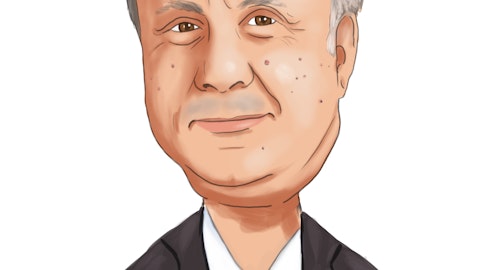Maurice Raycroft: I was going to ask about multiple myeloma with some of the data that you’re seeing in the third-line setting. I guess, are you breaking out that percentage from the 55% total? And can you talk about what exactly the treatment paradigm is that you’re seeing prior to third line? I guess, how well defined is that frontline and second-line treatment in the paradigm.
Richard Paulson: Yes. Thanks, Maury. I’ll get Sohanya talk to that. Sohanya?
Sohanya Cheng: Yes. Thanks, Maury, for the question. So our most rapid area of growth within that second to fourth line bucket is in the third line. That is a large contributing factor to that nice upward trend that we’re seeing in the second to fourth line. And as you know, we now see 55% of our patients in that bucket. Little hard given the data that we see to break down exact numbers by line of therapy, but we know that third line is a contributing factor. And in 2023, our focus will remain on accelerating our growth in the third line. Now switching to the dynamics in the first and second line. we see the use of the major 3 classes upfront. But primarily, the trend that we’re seeing is an increase in the use of the anti-CD38 antibody in the first and the second line.
As a result, that unmet need is growing for in effective manageable treatment following an anti-CD38. And that is where we have actively generated data to demonstrate the rationale and efficacy of XPOVIO immediately following an anti-CD38.
Maurice Raycroft: Got it. That’s helpful. And is this third line setting, is this aligning with your community uptake data? And do you expect this to be a key driver behind your future growth expectations in the community setting?
Sohanya Cheng: Absolutely. We see that again, the most rapid growth in the third line the community, as you know, when they start off prescribing a drug, these community physicians see a variety of patients across tumor types. So when they start of any new therapy, they can come across a couple of initial hurdles. With XPOVIO, given the time into the launch that we are, they’ve crossed a lot of these initial hurdles. And now it’s really about moving them into earlier lines and continuing to build the confidence that they already have from some of those initial experiences.
Maurice Raycroft: Got it. Makes sense. And I was going to ask one question on Myelofibrosis too. Just wondering if you can give any granularity on timing for the additional data, the recommended Phase II dose and the Phase III start updates in the first half ’23 and what do you need to see from the 40 mg data to go forward with that dose? Or what are your latest thoughts on dosing strategy for that study?
Richard Paulson: Hey, Reshma, do you want to capture that one?
Reshma Rangwala: Yes, absolutely. And thanks for the question. So the next update is going to occur sometime in the first half of 2023. The update again is just to include the patients, the 24 patients that were enrolled as part of the Phase I. So all of these patients, again, were treated with the combination of Selinexor and Ruxolitinib and they’re all treatment-naive patient populations. We’re following all of them for maturities. So the key time point that we want to assess their SVR, TSS50, hemoglobin and safety is specifically going to be at that 24-week and beyond. So as we continue to follow these patients, it’s going to help guide the optimal timing of when we can provide that update again across those key efficacy as well as safety endpoints as well as additional data, including translational data, an important subgroup data as well.
In terms of how we identify the recommended Phase II dose, we’re going to look across multiple parameters. So it’s going to be about the efficacy again that we specifically see at the week 24. Of course, that important safety profile, but we also need to incorporate pharmacodynamic data, too. So stay tuned for the update. Again, it will occur in the first half of this year.
Operator: The next question comes from Chris Raymond of Piper Sandler.
Nicole Gabreski: This is Nicole Gabreski on for Chris. Maybe just 2 for us. The first, just for the pivotal Phase III frontline study and Myelofibrosis, I guess, can you just provide some more color around the regulatory feedback you’re waiting for in order to initiate that study? And then I guess, second, just with Endometrial cancer. I know that you guys have indicated that you’ll present updated subgroup results from SIENDO this year. Maybe can you just help frame what updated data we should expect to see and if there is a particular venue or venues that we should maybe think about as a good for the update.
Richard Paulson: I’ll turn to…
Reshma Rangwala: I’m sorry about that. Jumping on there. But great question. So in terms of the next steps for the Myelofibrosis program, again, it’s going to be that data that I just mentioned in the previous question, the efficacy and the safety, the pharmacodynamics, the dose. And then, of course, just getting alignment from the FDA on the design and statistical analysis plan for the Phase III. So that meeting is going to occur sometime in the first half of this year. And then we look forward to presenting the trial design along with the updated data again in the first half of this year. But I will say, we’ve got a lot of other precedents out there in terms of this first-line space. So looking at a combination versus Ruxolitinib is likely something that we are going to pursue as well.
And we’re going to focus on the end points that are relevant to the patient population, specifically SVR35 as well as the TSS50 at week 24, but also look at important aspects, including hemoglobin stabilization and then, of course, that the safety profile as well. In terms of Endometrial cancer, so an important update that we presented on this earnings call was a recent update on the PFS results from the SIENDO subgroup. So based upon a November 2022 cut, we reanalyzed the progression-free survival, specifically in those P53 wild-type patients, which comprise approximately 50% of all Endometrial cancer and very encouraged by the updated results. What we’ve now seen is that median progression-free survival for the Selinexor arm has increased from 13.7 months to now 20.8 months.
The placebo arm by and large, has stayed the same and the most recent update shows a median PFS of 5.2% for placebo. So very, very, very encouraged by the now quadrupling in that median PFS observed for the Selinexor treated patients. We continue to follow all of these patients and we’ll update PFS, also looking at overall survival too. As those events accrue, we’ll look to present those updated data.
Operator: The next question comes from Mike Ulz of Morgan Stanley.
Michael Ulz: Maybe just one on the Myelofibrosis strategy. Just based on some of the data you highlighted in your prepared remarks, are you thinking about potentially moving monotherapy in frontline Myelofibrosis? And then maybe secondly, can you just give us your current thinking on the strategy in second line at this point?
Reshma Rangwala: I was going to wait for Richard, but I’m going to go ahead and get in there. Great question. So our focus right now is absolutely the combination of Selinexor and Ruxolitinib largely based upon the very compelling results that we continue to see from the Phase I portion of the 034 study. So looking forward to interacting with the FDA and then initiating that trial in the first half of this year. With that said, though, there are some very important learnings from the Phase I portion that suggest that Selinexor really is a fundamental mechanism within Myelofibrosis, across the patient population, and it affords us an opportunity to really maximize the development of Selinexor in this important patient population, whether it’s looking at monotherapy, novel combinations, et cetera. But that is something that we want to define in the future. Our focus right now is absolutely the combination of Selinexor and Ruxolitinib.
Operator: Next question comes from Brian Abrahams of RBC.
Unidentified Analyst: This is Joe on for Brian. I have 2. So first one on the Eltanexor. What you would like to demonstrate from the interim data. And also, if you could tell us a little more about sort of like the latest data cut you saw in the Endometrial cancer and how that shapes your expectation in the new Phase III data in terms of both PFS and OS.
Richard Paulson: Thanks, Joe, I’ll turn to Reshma for both of those.



